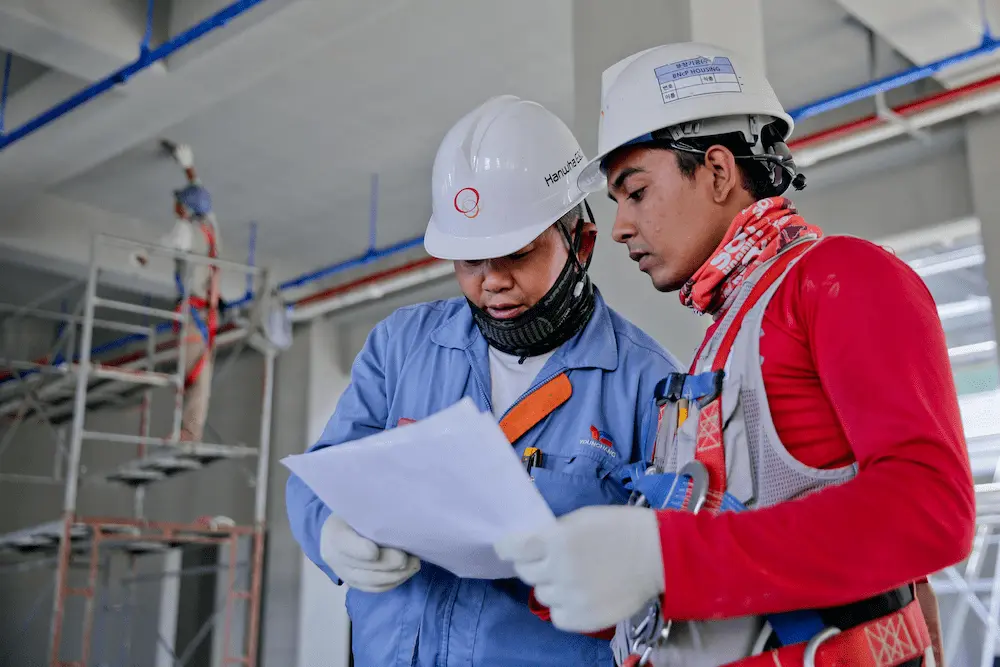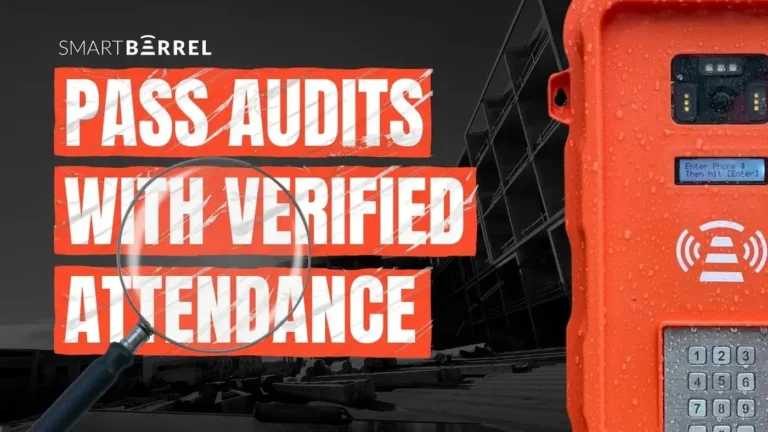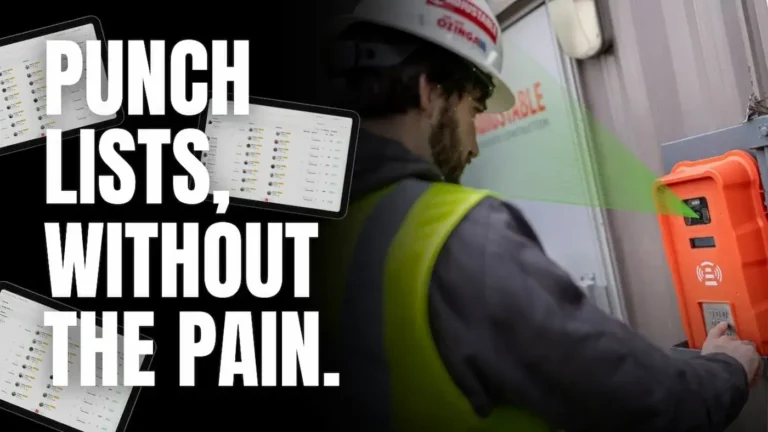Modern construction can’t rely on outdated paperwork. From timecards and change orders to compliance reports and daily logs, construction projects generate a constant stream of documentation.
When these records are scattered across spreadsheets, emails, and physical files, they create:
- Confusion
- Delays
- Costly miscommunication
To escape the struggle, today’s leading contractors are turning to digital tools that streamline document management and improve project response times. They centralize records, automate workflows to reduce administrative overhead, and maintain strong control over project timelines.
In this article, we’ll explore how digital platforms are simplifying construction document management, and how your team can do the same.
What Is Construction Document Management and Why It Matters in 2025?

Construction document management refers to the system that organizes, accesses, and tracks project documents such as time cards, change orders, safety reports, RFIs, permits, and compliance records.
These documents are the backbone of every project. But when these files are managed manually, scattered across jobsite trailers, inboxes, whiteboards, and spreadsheets, it creates friction across teams, timelines, and approvals.
For superintendents, project managers, and back-office staff, the bigger the project, the more paperwork piles up.
But here’s how digital adoption can simplify this process and save you tons of time.
Take Back Control of Your Time Keeping
10 Ways Digital Tools Simplify Construction Document Management
Before digital solutions, managing construction document software meant endless back-and-forth, handwritten logs, and version mix-ups. Now, with the right tools in place, those same processes are faster, more reliable, and easier to track in real-time.
Here are 10 specific ways construction teams are simplifying document management through smart, streamlined workflows.
1. Centralizing Documents in One Cloud-Based Location
Construction projects generate a constant flow of documents, and managing them with accuracy and consistency is no small task.
Online document managers solve this by centralizing everything in one secure platform. Instead of jumping between apps, emails, or paper folders, your team can access the latest documents from any device, on-site or in the office.
Case Study: Tocci Building Corporation
Tocci Building Corporation implemented the Document Locator digital document management system to address challenges in managing project documents.
The adoption of the Document Locator provided Tocci with a centralized repository featuring automatic versioning, security, full-text indexing, and comprehensive search tools.
This system allowed project team members to quickly find the right documents, reducing time spent searching and minimizing errors associated with outdated information.
2. Real-Time Time Tracking To Eliminate Manual Errors
When hours are written down by hand or passed along through texts and verbal check-ins, the result is often:
- Incomplete records
- Payroll mistakes
- The time-consuming back-and-forth between the field and office
Switching to real-time tracking removes those bottlenecks. Instead of waiting until the end of the day or week to submit hours, workers clock in and out on-site. The data flows directly into the system and is tied to the correct crew, cost code, and project.
For project managers, that means fewer surprises when reviewing labor costs. For payroll teams, it reduces manual entry, flags inconsistencies early, and improves turnaround time.
3. Faster Timecard Approvals and Payroll Processing
Waiting on timecard approvals can create a domino effect of delays across the jobsite and back office. When timecards are submitted late, handwritten, or missing signatures, payroll gets pushed back, job costing becomes inaccurate, and trust between crews and management starts to wear thin.
Digital approval workflows simplify this by allowing supervisors to review, edit, and approve timecards in real-time. No need to track down paper sheets or wait until the end of the week. As soon as workers clock out, their hours are ready for review and tagged by jobsite, crew, and cost code.
Managers can approve entries with a few clicks, and payroll teams get clean, verified data that’s ready to process.
The result is faster payroll cycles, fewer disputes over hours, and better visibility into labor spending. It also means workers are paid accurately and on time.
4. Daily Reports Without the Paper Chase
Daily reports are a must for documenting jobsite progress, tracking delays, and keeping stakeholders informed.
But when they rely on clipboards, spreadsheets, or handwritten notes, the process becomes clunky and inconsistent. Field supervisors often fill them out at the end of a long day, and by the time reports reach the office, they’re missing details or filed too late to be useful.
Instead of old methods, SmartBarrel daily logs allow teams to submit reports in real time, directly from the jobsite. Hours worked, weather conditions, work summaries, and safety incidents are all logged on the spot. Once submitted, reports are immediately available to office teams in a clean, consistent, and searchable format.
5. Controlling Document Versions to Avoid Rework
Outdated documents are one of the most common (and costly) sources of error on construction sites. When crews work off the wrong set of plans or reference an older checklist, it leads to miscommunication, rework, and schedule delays.
Digital documents are easier to track and manage. The latest files, drawings, spec sheets, and safety protocols can be marked and accessible only in their current form. Older versions stay archived but out of the active rotation, reducing the chance that someone grabs the wrong file.
6. Providing Instant, Mobile Access to Project Documents
In construction, timely access to accurate information is important.
SmartBarrel’s real-time data collection allows contractors and project managers to receive quick time tracking feedback and maintain control from anywhere on-site using AI-powered facial verification.
The system captures worker attendance, timestamps, and cost code data without manual input. This information is automatically integrated into daily logs, providing a current and accurate snapshot of jobsite activity, based on verified inputs from the field.
7. Automating Repetitive Document Workflows
In construction, automation refers to setting up workflows that run without manual input, based on predefined triggers or rules. These workflows can handle repetitive admin tasks that typically slow down both field and office teams.
For example, SmartBarrel helps automate time tracking approvals and daily log generation by pulling real-time jobsite data tagged to crews, cost codes, and timestamps.
With fewer manual steps involved, project managers spend less time chasing paperwork and more time focusing on what moves the build forward.
8. Improving Collaboration with Shared Document Access
Construction projects involve multiple moving parts and even more people. When teams don’t have access to the same information at the same time, collaboration breaks down. Updates get missed. Instructions get misinterpreted.
Shared document access helps prevent that. When field teams, project managers, and office staff can all view the same set of documents, communication becomes faster. Everyone knows what’s been submitted, what’s pending, and what’s changed.
This kind of visibility cuts down on confusion and builds trust across departments.
9. Integrating with Existing Platforms for a Smooth Data Flow
The most effective construction tools reduce admin work by integrating directly with the systems your team already uses. When platforms connect smoothly, from time tracking to payroll or project management, information flows automatically, and teams spend less time on duplicate entry.
Unfortunately, many tools fall short when it comes to seamless integration with existing platforms.
SmartBarrel solves this by integrating with leading platforms like Procore, CMiC, and Viewpoint Vista. Timecards, logs, and jobsite data sync directly with your core systems helping everyone from the field to the back office stay aligned with less effort.
10. Protecting Sensitive Data with Secure Digital Storage
Construction teams manage more than just plans and schedules. Payroll records, compliance documents, certifications, and incident reports all contain sensitive data that can’t afford to fall into the wrong hands.
Storing these documents in secure, cloud-based systems helps reduce the risk of loss or unauthorized access. Teams can control who sees what, ensuring the right people always have access to the latest information, and no one else does. Backup protocols, access logs, and encrypted file storage add extra layers of protection.
Take Back Control of Your Time Keeping
How to Introduce Digital Tools on the Jobsite (Without the Pushback)

Introducing too many digital tools at once is rarely effective. It can overwhelm field crews and lead to frustration rather than adoption.
Let us share three practical tips to bring technology to the worksite and improve your efficiency.
#Tip 1: Start with One Jobsite, Then Scale
With a new tool on the jobsite, pilot it on one active jobsite where the field team is open to innovation. This smaller-scale launch gives you a chance to test real-world use, gather feedback, and iron out any issues before going company-wide.
Start with core features like time tracking or daily logs, before layering on additional workflows. Choose a foreman or superintendent to champion the rollout and communicate updates to the rest of the crew.
#Tip 2: Train the Field First, Not Last
One of the biggest mistakes in tech rollouts is training office staff first and expecting the field to catch up. But adoption starts from the jobsite, where the tool is used most.
Schedule short, focused training sessions with crew leads and field supervisors. Use mobile devices to show exactly how the tool works in real scenarios: clocking in, submitting a report, reviewing hours. Keep it hands-on, visual, and field-tested.
Make someone on-site the go-to person for troubleshooting. Give them a direct line to support so small issues don’t become blockers.
#Tip 3: Connect the Tool to Real-World Pain Points
To get lasting buy-in, the tool has to solve real problems. Show how the tool directly fixes daily frustrations like missing timecards, late approvals, or payroll disputes.
When introducing SmartBarrel or any similar platform, tie each function to something the team already struggles with. For example, you can tell the workers:
- “No more texting in hours at 9 PM, we’ll use this to clock in and out automatically.”
- “If there’s an incident on-site, you can file it from your phone. No extra paperwork.”
- “You’ll get paid for what’s actually worked, no back-and-forth on missed shifts.”
Keep the messaging simple, and lead with what’s in it for them: less paperwork, fewer errors, more accurate hours. When field crews see the tool as a solution, they’re much more likely to use it consistently.
Take Back Control of Your Time Keeping
Smarter Systems, Smoother Projects
Construction document management doesn’t have to be a daily headache. Having the right tools and workflows in place, you can eliminate confusion, reduce costly delays, and give both field and office teams more control over the workday.
Book a demo today and see how SmartBarrel can simplify your site’s document management, starting day one.
Construction Document Management FAQ
What’s the difference between document storage and document management?
Storage simply keeps your files in one place, like a digital filing cabinet. Document management, on the other hand, adds structure: version control, access permissions, workflows, and tracking. It helps teams collaborate, reduce errors, and ensure documents are actually used.
How often should construction teams update or audit their digital document system?
At a minimum, review your system every quarter. Check for outdated files, permission issues, or gaps in daily reporting. Auditing regularly helps avoid version confusion, improves compliance, and ensures your workflows match current site needs.
Can smaller construction firms benefit from document management systems?
Yes. In fact, small- to mid-sized contractors often see the most immediate impact, fewer missed documents, faster approvals, and less admin overhead.
How can digital document tools help with subcontractor management?
They help track subcontractor hours, submitted reports, compliance paperwork, and safety logs, all in one place.
What happens to my documents if I switch systems later?
Most platforms allow you to export your data. However, it’s smart to ask about file ownership, export formats, and data retention before you sign up.
How do I measure ROI on a construction document management system?
Track the time saved on admin tasks, reduction in rework, faster payroll cycles, and how quickly issues get resolved. If you’re managing multiple sites, even a small improvement in communication and accuracy can lead to major savings across the board.




